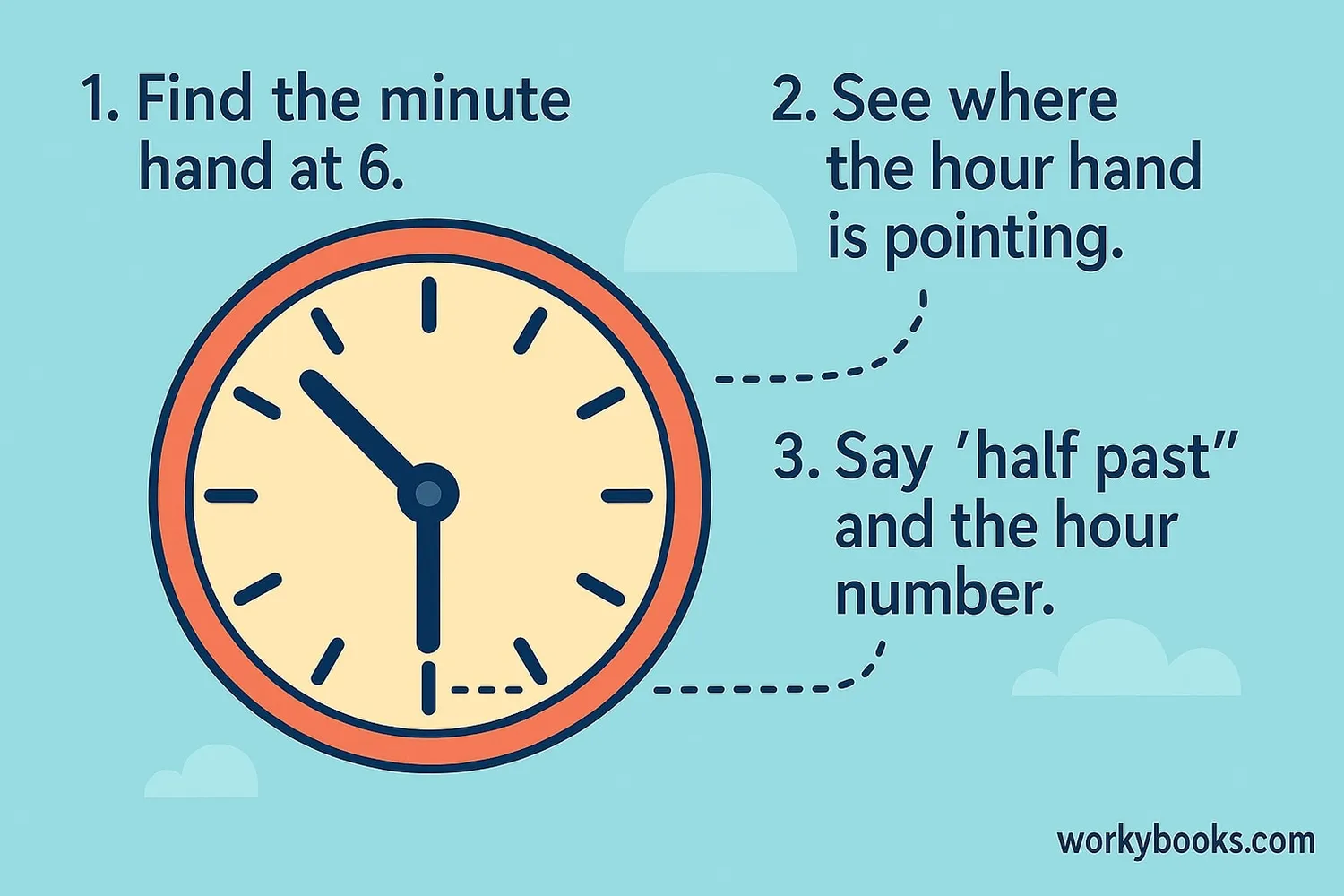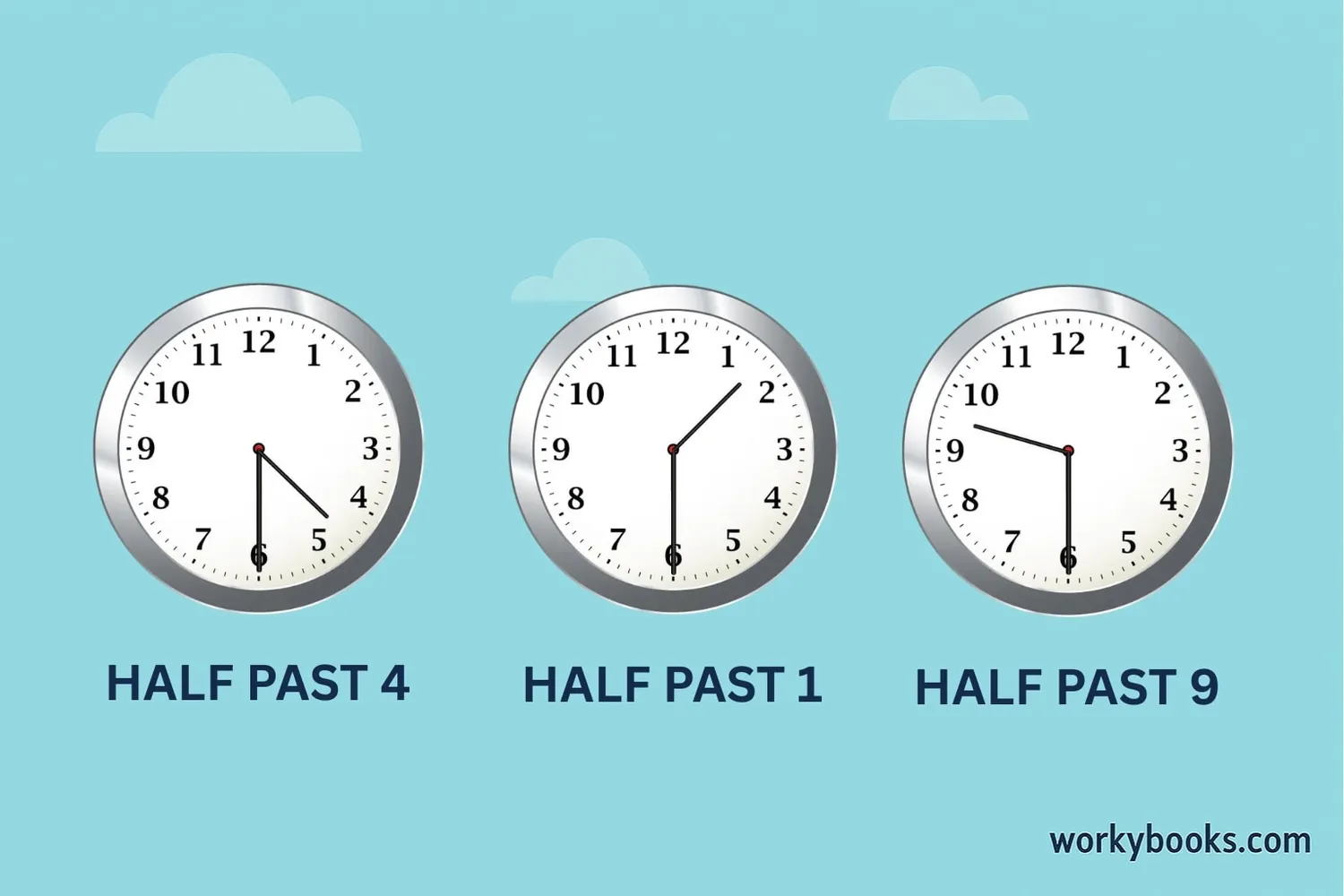Half Past Time - Definition, Examples, Quiz, FAQ, Trivia
Learn to tell time using 'half past' with easy explanations and practice activities
What is Half Past?

"Half past" is a way to tell time when the minute hand is pointing at the 6 on the clock face. This means 30 minutes have passed since the last hour.
When we say "half past," it means we are halfway through the current hour. For example, when the minute hand points to the 6 and the hour hand is between 1 and 2, we say it's "half past 1" or 1:30.
The word "half" refers to half of an hour, which is 30 minutes. "Past" tells us that this time has passed after the hour. Understanding "half past" helps us read analog clocks and understand time intervals.
Key Concept
Half past means 30 minutes after the hour. The minute hand points to the 6, and the hour hand is halfway between two numbers.
How to Tell Half Past Time

Telling time using "half past" is easy when you follow these steps:
Steps to Tell Half Past
- Look at the minute hand first
- If it's pointing to the 6, it's half past
- Then look at the hour hand
- The hour is the number the hour hand just passed
- Say "half past" and that hour number
Example: The minute hand is at 6, and the hour hand is between 3 and 4.
Step 1: Minute hand at 6 → It's half past
Step 2: Hour hand between 3 and 4 → It just passed 3
Step 3: Say "half past 3" or 3:30
Remember, the hour hand moves slowly between numbers as time passes. At exactly half past, it's halfway between two numbers.
Remember
The minute hand must point exactly to the 6 for it to be "half past" the hour. If it's not exactly at 6, it's not exactly half past.
Examples of Half Past Times

Let's look at some examples of half past times:
Example 1: Half past 4 (4:30)
- Minute hand: pointing to 6
- Hour hand: halfway between 4 and 5
Example 2: Half past 7 (7:30)
- Minute hand: pointing to 6
- Hour hand: halfway between 7 and 8
Example 3: Half past 11 (11:30)
- Minute hand: pointing to 6
- Hour hand: halfway between 11 and 12
Example 4: Half past 12 (12:30)
- Minute hand: pointing to 6
- Hour hand: halfway between 12 and 1
Practice reading half past times on analog clocks you see around you - on walls, in classrooms, or on watches!
Practice Tip
Draw clock faces showing different half past times. This will help you remember how the hands look for each time.
Time Telling Practice Quiz
Test your understanding of half past times with this 5-question quiz. Choose the correct answer for each question.
Frequently Asked Questions
Here are answers to common questions about half past times:
Time Trivia
Discover interesting facts about time and clocks:
Ancient Timekeeping
The earliest known timekeeping devices were sundials, used as early as 3500 BCE. Water clocks and hourglasses came later, before mechanical clocks were invented in medieval Europe.
Why 60 Minutes?
The division of an hour into 60 minutes comes from ancient Babylonian mathematics, which used a base-60 number system. This system was later adopted by Greek astronomers and spread throughout the world.
First Mechanical Clocks
The first mechanical clocks were invented in Europe in the 14th century. They didn't have minute hands at first—only hour hands. Minute hands were added later as clockmaking became more precise.
World's Oldest Clock
The world's oldest working clock is in Salisbury Cathedral, England, dating back to 1386. It has been telling time for over 600 years!





